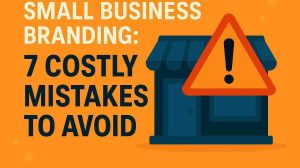
In today’s hyper-connected world, your reputation travels faster than you do. Before you step into a room, join a meeting, or even send an email, people are already forming opinions about you—thanks to what they see and read online. Whether you’re a corporate leader, an entrepreneur, a freelancer, or a job seeker, having a personal branding strategy is no longer optional—it’s a career survival skill.
Think of your personal brand as your digital handshake—it tells the world who you are, what you stand for, and why you matter. The right strategy doesn’t just open doors; it keeps them open for the long haul. And the data backs this up: according to LinkedIn research, 70% of employers check candidates’ online presence before making hiring decisions, and those with a strong, consistent personal brand are 50% more likely to receive job offers or promotions.
But here’s the good news: you don’t need to be a celebrity or have millions of followers to create a brand that resonates. With the right steps, you can build your personal brand in a way that attracts opportunities, grows your influence, and positions you as a trusted authority in your field.
In this guide, we’ll break down seven proven steps to craft a powerful personal branding strategy—with real-world examples, research-backed insights, and actionable tips you can start implementing today.
Personal Branding Strategy
1. Define Your Brand Identity with Precision
Your personal brand development starts with clarity. Ask yourself: What do I want to be known for? Who am I trying to reach? This step is about identifying your brand positioning—the space you want to own in your audience’s mind.
Action Steps:
- Write down your top three professional strengths.
- Define your unique value proposition (UVP) in one sentence.
- Identify your ideal audience: Are you speaking to potential employers, clients, industry peers, or a mix?
Example: Elon Musk’s personal brand identity is centered around innovation, disruption, and futuristic thinking. Every tweet, interview, and public appearance reinforces this image.
Pro Tip: Avoid trying to appeal to everyone. The most successful personal brands are specific, even polarizing.
While crafting your personal branding strategy, it’s helpful to explore different frameworks and tips from related content on this site. This guide, Strategi Membangun Personal Branding: 6 Cara Efektif Menonjol di Era Digital, delves into practical tactics that complement our current step-by-step approach—adding extra nuance and examples to your strategy toolbox.
2. Craft a Compelling Brand Story
Facts tell, but stories sell. Your brand story is the emotional connector that turns casual observers into loyal advocates. It should weave together your background, challenges, turning points, and achievements in a way that feels authentic and inspiring.
Action Steps:
- Use the “Hero’s Journey” framework—start with a challenge, describe your journey, and show the transformation.
- Highlight your passion and purpose, not just your credentials.
- Keep it relatable—share failures and lessons learned.
Stat: Research by Stanford University shows that stories are remembered up to 22 times more than facts alone.
Example: Oprah Winfrey’s personal brand story—rising from poverty to becoming one of the most influential women in media—is an essential part of why her brand resonates globally.
3. Optimize Your Online Presence
Your online presence is the first—and sometimes only—impression you’ll make. From LinkedIn profiles to personal websites, every digital touchpoint should align with your personal branding strategy.
Action Steps:
- Audit your existing social media and remove outdated or irrelevant content.
- Use consistent profile photos, bios, and brand colors across all platforms.
- Create a personal website to showcase your portfolio, achievements, and testimonials.
Stat: A CareerBuilder survey revealed that 54% of employers have eliminated candidates from consideration based on online content.
Golden Tip: When someone Googles your name, the first three results shape their perception. Control them by optimizing your profiles with relevant content and SEO best practices.
4. Consistently Create Value-Driven Content
You can’t have a strong personal branding strategy without content that proves your expertise. Consistency builds trust, and trust builds influence.
Action Steps:
- Choose 2–3 content formats you’re comfortable with (articles, videos, podcasts, infographics).
- Share a mix of educational, inspirational, and personal insights.
- Repurpose content across multiple platforms for maximum reach.
Example: Gary Vaynerchuk built his empire by posting valuable marketing content daily across LinkedIn, YouTube, TikTok, and Instagram.
Stat: HubSpot reports that consistent blogging can drive up to 67% more leads compared to brands that don’t publish regularly.
5. Leverage Networking to Amplify Your Reach
A personal branding strategy without networking is like a car without fuel—it won’t take you far. Strategic relationships can multiply your visibility and credibility.
Action Steps:
- Attend industry conferences, webinars, and networking events.
- Collaborate with influencers or thought leaders in your niche.
- Engage meaningfully with others’ content—comment, share, and contribute insights.
Example: Richard Branson’s approachable networking style—meeting people on islands, in airports, and at events—has helped Virgin Group become synonymous with adventurous business.
6. Master Reputation Management
Your reputation is your brand’s currency. A single negative review, tweet, or misstep can damage years of work if not handled well.
Action Steps:
- Set up Google Alerts for your name to monitor mentions.
- Respond professionally to criticism; acknowledge valid points and offer solutions.
- Highlight positive testimonials and endorsements in your profiles.
Stat: According to BrightLocal, 87% of consumers read online reviews for businesses, and the same behavior extends to personal brands.
7. Evolve and Adapt Your Strategy Over Time
Markets change, industries shift, and so should your personal brand development. An outdated brand can make you irrelevant, no matter your experience.
Action Steps:
- Review your branding annually and update visuals, bios, and messaging.
- Stay ahead of industry trends and incorporate them into your brand narrative.
- Test new platforms—don’t ignore emerging channels like TikTok or LinkedIn newsletters.
Example: Dwayne “The Rock” Johnson successfully transitioned his brand from wrestling to acting to business, keeping his audience engaged across decades.
Wrap It Up: Your Personal Brand is Your Long-Term Investment
A powerful personal branding strategy is more than just a logo or a LinkedIn headline—it’s the sum of your actions, communications, and relationships over time. By defining your identity, telling a compelling story, optimizing your presence, creating consistent value, networking effectively, managing your reputation, and adapting to change, you position yourself as a leader worth remembering.
Remember, the best time to start building your personal brand was yesterday. The next best time is now.



